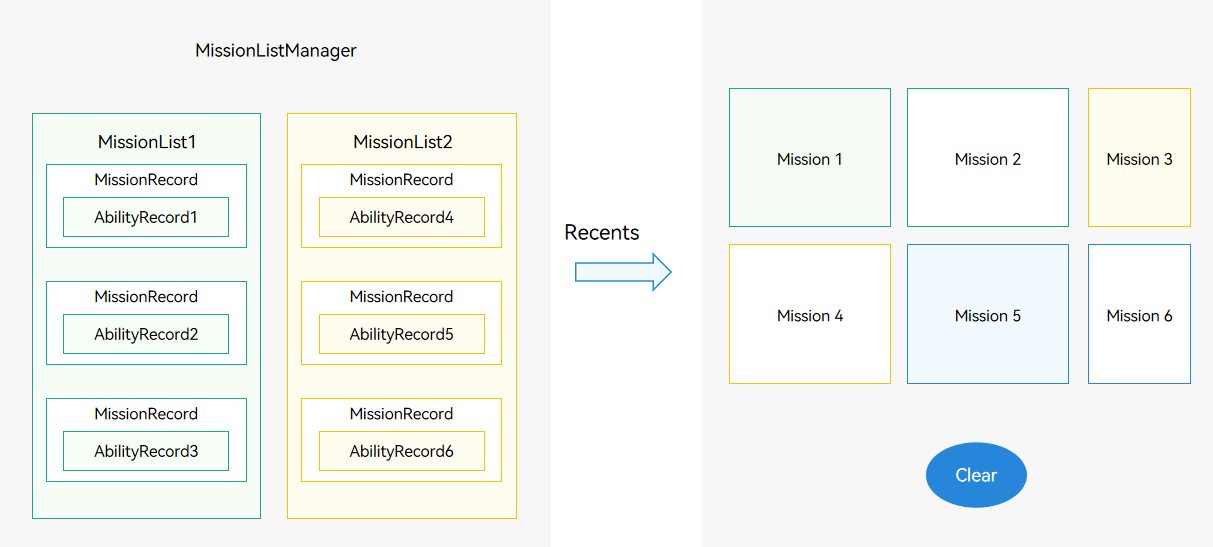harmony 鸿蒙Mission Management Scenarios
Mission Management Scenarios
Before getting started with the development of mission management, be familiar with the following concepts related to mission management:
AbilityRecord: minimum unit for the system service to manage a UIAbility instance. It corresponds to a UIAbility component instance of an application. A maximum of 512 UIAbility instances can be managed on the system service side.
MissionRecord: minimum unit for mission management. One MissionRecord has only one AbilityRecord. In other words, a UIAbility component instance corresponds to a mission.
MissionList: a list of missions started from the home screen. It records the startup relationship between missions. In a MissionList, a mission is started by the mission above it, and the mission at the bottom is started by the home screen.
MissionListManager: system mission management module that maintains all the MissionLists and is consistent with the list in Recents.
Figure 1 Mission management

Missions are managed by system applications (such as home screen), rather than third-party applications. Users interact with missions through Recents. After creating a mission, users can perform the following operations on Recents:
Delete a mission.
Lock or unlock a mission. (Locked missions are not cleared when users attempt to clear all missions in Recents.)
Clear all missions in Recents.
Switch a mission to the foreground.
A UIAbility instance corresponds to an independent mission. Therefore, when an application calls startAbility() to start a UIAbility, a mission is created.
To call missionManager to manage missions, the home screen application must request the ohos.permission.MANAGE_MISSIONS permission. For details, see Requesting Permissions for system_basic Applications.
You can use missionManager to manage missions, for example, listening for mission changes, obtaining mission information or snapshots, and clearing, locking, or unlocking missions.
import { missionManager } from '@kit.AbilityKit'; import { BusinessError } from '@kit.BasicServicesKit'; import { image } from '@kit.ImageKit'; import { promptAction } from '@kit.ArkUI'; import { hilog } from '@kit.PerformanceAnalysisKit'; const TAG: string = 'TaskManager'; const DOMAIN_NUMBER: number = 0xFF00;private listenerId: number = 0; private missionId: number = 0; private listener: missionManager.MissionListener = { // Listen for mission creation. onMissionCreated: (mission: number) => { hilog.info(DOMAIN_NUMBER, TAG, '--------onMissionCreated-------'); }, // Listen for mission destruction. onMissionDestroyed: (mission: number) => { hilog.info(DOMAIN_NUMBER, TAG, '--------onMissionDestroyed-------'); }, // Listen for mission snapshot changes. onMissionSnapshotChanged: (mission: number) => { hilog.info(DOMAIN_NUMBER, TAG, '--------onMissionMovedToFront-------'); }, // Listen for switching the mission to the foreground. onMissionMovedToFront: (mission: number) => { hilog.info(DOMAIN_NUMBER, TAG, '--------onMissionClosed-------'); }, // Listen for mission icon changes. onMissionIconUpdated: (mission: number, icon: image.PixelMap) => { hilog.info(DOMAIN_NUMBER, TAG, '--------onMissionIconUpdated-------'); }, // Listen for mission name changes. onMissionLabelUpdated: (mission: number) => { hilog.info(DOMAIN_NUMBER, TAG, '--------onMissionLabelUpdated-------'); }, // Listen for mission closure events. onMissionClosed: (mission: number) => { hilog.info(DOMAIN_NUMBER, TAG, '--------onMissionClosed-------'); } };// 1. Register a mission change listener. this.listenerId = missionManager.on('mission', this.listener); promptAction.showToast({ message: 'register_success_toast' }); hilog.info(DOMAIN_NUMBER, TAG, `missionManager.on success, listenerId = ${this.listenerId}`);// 2. Obtain the latest 20 missions in the system. missionManager.getMissionInfos('', 20, (error: BusinessError, missions: Array<missionManager.MissionInfo>) => { if (error.code) { hilog.error(DOMAIN_NUMBER, TAG, `getMissionInfos is called, error code: ${error.code}, err msg: ${error.message}.`); return; } hilog.info(DOMAIN_NUMBER, TAG, `size = ${missions.length}.`); hilog.info(DOMAIN_NUMBER, TAG, `missions = ${JSON.stringify(missions)}.`); //Check whether Recents in the system contains etsclock. for (let i = 0;i < missions.length; i++) { if (missions[i].want.bundleName === 'ohos.samples.etsclock') { promptAction.showToast({ message: 'obtain_success_toast' }); hilog.info(DOMAIN_NUMBER, TAG, `getMissionInfos.find etsclock, missionId = ${missions[i].missionId}`); this.missionId = missions[i].missionId; return; } } promptAction.showToast({ message: 'obtain_failed_toast' }); });// 3. Obtain the detailed information about a mission. missionManager.getMissionInfo('', this.missionId).then((data: missionManager.MissionInfo) => { promptAction.showToast({ message: JSON.stringify(data.want.bundleName) }); hilog.info(DOMAIN_NUMBER, TAG, `getMissionInfo successfully. Data: ${JSON.stringify(data)}`); }).catch((error: BusinessError) => { hilog.info(DOMAIN_NUMBER, TAG, `getMissionInfo failed. Cause: ${error.message}`); });// 4. Obtain the mission snapshot. missionManager.getMissionSnapShot('', this.missionId, (error: BusinessError, snapshot: missionManager.MissionSnapshot) => { if (error === null) { promptAction.showToast({ message: 'obtain_snapshot_success_toast' }); } hilog.info(DOMAIN_NUMBER, TAG, `getMissionSnapShot is called, error code: ${error.code}, error msg: ${error.message}.`); hilog.info(DOMAIN_NUMBER, TAG, `bundleName = ${snapshot.ability.bundleName}.`); })// 5. Obtain the low-resolution mission snapshot. missionManager.getLowResolutionMissionSnapShot('', this.missionId, (error: BusinessError, snapshot: missionManager.MissionSnapshot) => { if (error === null) { promptAction.showToast({ message: 'obtain_low_snapshot_success_toast' }); } hilog.info(DOMAIN_NUMBER, TAG, `getLowResolutionMissionSnapShot is called, error code: ${error.code}, error msg: ${error.message}.`); hilog.info(DOMAIN_NUMBER, TAG, `bundleName = ${snapshot.ability.bundleName}.`); })// 6-1. Lock the mission. missionManager.lockMission(this.missionId).then(() => { promptAction.showToast({ message: 'lock_success_toast' }); hilog.info(DOMAIN_NUMBER, TAG, 'lockMission is called '); });// 6-2. Unlock the mission. missionManager.unlockMission(this.missionId).then(() => { promptAction.showToast({ message: 'unlock_success_toast' }); hilog.info(DOMAIN_NUMBER, TAG, 'unlockMission is called '); });// 7. Switch the mission to the foreground. missionManager.moveMissionToFront(this.missionId).then(() => { hilog.info(DOMAIN_NUMBER, TAG, 'moveMissionToFront is called '); });// 8. Clear a single mission. missionManager.clearMission(this.missionId).then(() => { promptAction.showToast({ message: 'delete_success_toast' }); hilog.info(DOMAIN_NUMBER, TAG, 'clearMission is called '); });// 9. Clear all missions. missionManager.clearAllMissions().catch((err: BusinessError) => { hilog.info(DOMAIN_NUMBER, TAG, `${err.code}`); });// 10. Deregister the mission change listener. missionManager.off('mission', this.listenerId, (error: BusinessError) => { if (error === null) { promptAction.showToast({ message: 'unregister_success_toast' }); } hilog.info(DOMAIN_NUMBER, TAG, 'unregisterMissionListener'); })
你可能感兴趣的鸿蒙文章
harmony 鸿蒙Obtaining Reasons for Abnormal Application Exits
harmony 鸿蒙UIAbility Backup and Restore
harmony 鸿蒙Using Explicit Want to Start an Application Component
harmony 鸿蒙Introduction to Ability Kit
harmony 鸿蒙AbilityStage Component Container
harmony 鸿蒙Accessing a DataAbility
harmony 鸿蒙Accessing a DataShareExtensionAbility from the FA Model
harmony 鸿蒙Common action and entities Values (Not Recommended)
- 所属分类: 后端技术
- 本文标签: